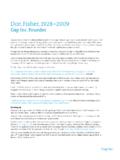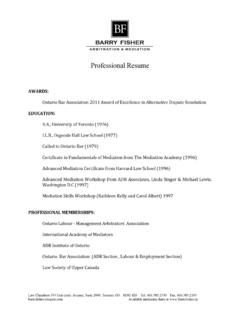Transcription of Cedar-Strip Canoe - wildfisher
1 1 Cedar-Strip Canoe One of the most beautiful and desired canoes is the Cedar-Strip Canoe . Until now you either had to pay someone upwards of $3000 to build you one, or wrestle your way through 300 pages of plans to build your own. These plans are just as in-depth as the more difficult plans, the difference is we have eliminated all of the duplicate information you really do not need to know to build one of these canoes. If you are like me, I know what you're probably thinking: 'I want a Canoe just like that, and I'd love to build one, but this is just too big and too difficult a project for me." I think you're in for a pleasant surprise. This is a large project, and it is time-consuming.
2 But it s like painting your house - lots of time and lots of work, but not all that difficult if you approach it properly. Unlike most forms of boat-building, a Cedar-Strip Canoe is very forgiving in its construction. A first-time Canoe builder with modest tool skills can build an excellent craft. This would be an excellent project to involve your teenage in. This Canoe is 18 ft. long, and is designed as a general-purpose family touring craft for camping and general flatwater paddling. It is not designed to run class 5 rapids. It's stable, moderately fast, carries plenty of weight, has no keel, and is easy to portage. This Canoe will weigh in at about 55 lbs.
3 When completed. The plans are presented in 3 logical steps; Part 1: Building the form on which to build your Canoe Part 2: Stripping the Canoe with cedar strips Part 3: Fiberglassing and finishing the Canoe . Each step includes a shopping list and a cutting list, directions and illustrations. It is suggested that you read the entire sequence of steps and familiarize yourself with the process before beginning your Canoe . Make sure you have a source of materials, the knowledge to put them together, the tools for the job, and the room to accommodate your efforts. When finished, you will be the proud owner of one of the most beautiful canoes ever designed. Follow the directions and illustrations for an easily built Canoe you can enjoy for years to come.
4 2 Part 1: Building the form on which to build your Canoe Assembling the wooden form on which your Canoe will be built. WHAT IS A Cedar-Strip Canoe , ANYWAY? The basic idea behind a Cedar-Strip Canoe is to make a hull of narrow wood strips , each one glued to the next with ordinary carpenter's glue, and then cover the hull with fiberglass, inside and out. The wooden hull by itself is weak, but the two layers of fiberglass make the Canoe extremely strong, lightweight and waterproof. No ribs are needed, no canvas covering, and no caulking. This "sandwich" construction, with the fiberglass as bread and wood as the filling, is also why this type of Canoe is very forgiving to a novice builder - the wooden strips don't have to be fitted very exactly, because the fiberglass covers all the gaps.
5 As we start to build the Canoe , we begin by assembling the "strongback," which is basically a long sawhorse on which to work. We then attach the molds, which are curved plywood pieces that the hull will be built on. The plans show clearly what the strongback and molds look like. WHAT IT TAKES TO BUILD You don't need the skills of an expert woodworker to make a Cedar-Strip Canoe . If you can operate a table saw or radial arm saw, you can do it. You do need patience and persistence, however. There are a lot of wooden strips to put on, and there's plenty of surface area to sand. You should count on it taking about 150 - 175 hours to finish the Canoe . In addition, the materials will cost around $450 - $500.
6 A garage or covered patio is the best place for building, because you need 12 - 16 ft. of clearance in front of and behind your saw for cutting the long strips . Furthermore, sanding the glued-up hull produces clouds of sawdust, and applying the fiberglass produces noxious fumes. You could work in a basement shop, but be sure you can get the finished Canoe out, and install a powerful fan to exhaust dust and fumes. The tools you will need are: Power tools: table saw or radial arm saw, jigsaw, electric drill, belt sander, orbital sander and router. Hand tools: wrenches, chalk line, ten 2-in. spring clamps, four 6-in. clamps, two staple guns, Surform file, hand plane, two 7 in.
7 Or 9 in. paint rollers and three trays, two paint scrapers, coping saw, and a combination square. Miscellaneous: church-key can opener or small tack puller, 20 clothespins, cartridge-type respirator, safety goggles, dust masks and rubber gloves. If you're ready, take a deep breath, and let's get started. 3 What you need for the first step. SHOPPING LIST ITEM QUANTITY 22 x 28" poster board 3 sheets 19 x 24" tracing paper 5 sheets x 4' x 8' exterior fir plywood 2 sheets 2 x 4" x 12' pine 7 1 x 6" x 8' pine 2 x 5" hex head bolts with nuts and washers 2 1-4 x 3" hex head bolts with nuts and washers 8 1/4" x 2-1/2" hex head bolts with nuts and washers 26 1/4" x 2" hex head bolts with nuts and washers 2 1/4" x 3" lag bolts 20 #6 x 2-1/2" drywall screws 50 #6 x 1-1/2" drywall screws 46 1 brads 50 1 x 10" x 16' cedar 3 4 CUT STRONGBACK PIECES TO SIZE This is possibly the most important step in building your Canoe .
8 Be precise and build your strongback level and straight. This is the beginning, and a mistake or sloppiness here will result in a Canoe that is hard to handle, or worse. Begin by cutting all the plywood pieces A - M to the dimensions given in the following Cutting List . Cut the leg supports (M) to their finished shapes. Cut the pine pieces N - U to their finished dimensions, then cut the tapered ends of the top pieces (U). CUTTING LIST KEY PIECES SIZE & DESCRIPTION A 1 1/2" x 20" x 24" fir plywood (grid layout board) B 2 1/2" x 12" x 18-1/2" fir plywood (end molds) C 2 1/2" x 6-1/4" x 16" fir plywood (molds 1 and 13) D 2 1/2" x 13-1/2" x 14-1/4" fir plywood (molds 2 and 12) E 2 1/2" x 13-1/4" x 20" fir plywood (molds 3 and 11) F 2 1/2" x 12-1/2" x 25" fir plywood (molds 4 and 10) G 2 1/2" x 12" x 30" fir plywood (molds 5 and 9) H 2 1/2" x 12" x 33-1/4" fir plywood (molds 6 and 8) J 1 1/2" x 12" x 34-1/4" fir plywood (mold 7) K 4 1/2" x 3-1/2" x 7" fir plywood (end mold supports) L 4 1/2" x 3-1/2" x 12" fir plywood (end mold supports)
9 M 2 1/2" x 10" x 20" fir plywood (leg supports) N 2 1-1/2" x 3-1/2" x 12' pine (strongback sides) P 2 1-1/2" x 3-1/2" x 48" pine (strongback ends) Q 4 1-1/2" x 3-1/2" x 24" pine (strongback centers and feet) R 2 1-1/2" x 3-1/2" x 36" pine (strongback legs) S 11 1-1/2" x 1-1/2" x 10" pine (mold supports) T 2 1-1/2" x 1-1/2" x 4" pine (mold supports) U 2 3/4" x 5-1/2" x 8'pine (strongback top) V 70 1/4" x 3/4" x 16' cedar (hull) The following page contains a diagram to help you with this process. Each square on the diagram equals 1 to help you transfer and increase the size of the molds. 5 6 THE GRID LAYOUT BOARD The grid layout board is used for drawing all the mold shapes to their full size.
10 The shapes are then transferred to poster board templates, and then to the plywood pieces B - J. This may seem like a cumbersome process, but the payoff is that your Canoe will be symmetrical and smooth. Draw the 1-in. grid on the grid layout board (A). To eliminate any confusion, transfer one set of mold shapes at a time. Start with molds l and 13. Transfer the intersecting points from our grid to yours. Draw the curves joining the intersecting points and complete the mold half s shape (Photos 1 & 2). Now transfer the remaining mold shapes, and the 1/2-in. hole locations. 7 8 MAKE POSTER BOARD TEMPLATES Trace the individual mold shapes to separate sheets of heavy tracing paper.




